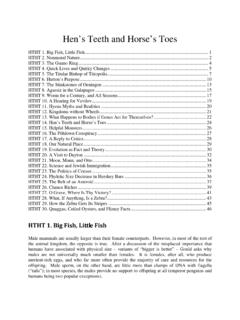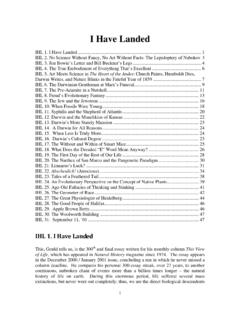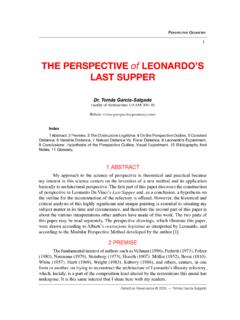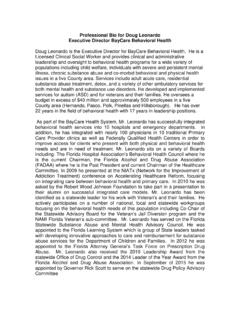Transcription of Leonardo’s Mountain of Clams And The Diet of Worms
1 1 Leonardo s Mountain of Clams And The Diet of Worms LM C 1. The Upwardly Mobile Fossils of Leonardo s Living Earth .. 1 LM C 2. The Great Western and the Fighting Temeraire .. 4 LM C 3. Seeing Eye to Eye, Through a Glass Clearly .. 5 LM C 4. The Clam Stripped Bare by Her Naturalists, Even .. 5 LM C 5. Darwin s American Soulmate: A Bird s-Eye View .. 7 LM C 6. A Seahorse for All Races .. 9 LM C 7. Mr. Sophia s Pony .. 10 LM C 8. Up Against a Wall .. 12 LM C 9. A Lesson from the Old Masters .. 13 LM C 10. Our Unusual Unity .. 14 LM C 11. A Cerion for Christopher .. 17 LM C 12. The Dodo in the Caucus Race .. 18 LM C 13. The Diet of Worms and the Defenestration of Prague .. 19 LM C 14. Non-Overlapping Magisteria .. 20 LM C 15. Boyle s Law and Darwin s Details .. 23 LM C 16. The Tallest Tale.
2 25 LM C 17. Brotherhood by Inversion (Or, As the Worm Turns) .. 27 LM C 18. War of the Worldviews .. 29 LM C 19. Triumph of the Root-Heads .. 31 LM C 20. Can We Truly Know Sloth and Rapacity? .. 32 LM C 21. Reversing Established Orders .. 33 LM C 1. The Upwardly Mobile Fossils of Leonardo s Living Earth One of Stephen Jay Gould s recurring themes is that it is important to consider a scientist, and all thinkers, within the context of their time. There are two types of pitfalls in viewing earlier generations in modern terms. The first is that we can underestimate the man and his views if we focus only on the fact that his proposals are recognized incorrect today. The second is that we may overestimate, or at least misunderstand, an earlier thinker who proposed something akin to what we believe today.
3 We can only truly understand and appreciate the history of ideas when we make the effort to see the world through the eyes of those who developed them. In this essay, Gould discusses the so-called Leicester Codex (a private notebook) of the great Leonardo da Vinci (1452 1519). In an age before Newton and Galileo, Leonardo filled secret, coded journals with insights that the rest of the world would struggle with for centuries. (Unfortunately, the contents of these journals remained unknown until after most of his findings had been re -discovered by others. Thus, Leonardo s impact on Western civilization was not nearly as great as it might have been.) The Leicester Codex 2 named for the 18th-century British Lord who bought it in 1717, about 20 years after it first surfaced in Rome is filled with astute observations and thoughts regarding the origins of fossil seashells, specifically those found in elevated strata far from the sea.
4 He did believe that these were artifacts of formerly living marine organisms, and that their current location suggested geological upheavals of former sea floors into today s mountains. These are the sorts of insights that lead many scholars to believe that he was a modern man (or at least a Victorian!) living in the 15th century a spaceman (Gould s term) or time-traveler of sorts. Supporters of this view argue that it was his careful observations and clever experiments signs of a man well ahead of his time that allowed him to overcome the restrictive, medieval scholasticism of his time. Not really, Gould warns. Leonardo did make careful observations, and did make an excellent case against two important views of the nature of earth and life; however, he did so from the context of his own medieval paradigm.
5 Gould introduces the two major paradigms of fossils that Leonardo demolishes. The first is that the great flood of Noah, described in the Bible, is responsible for transporting sea-dwelling creatures hundreds of miles inland. Leonardo pointed out that strata exposed by rivers match up across the divide, which indicates that the sediments that formed them were laid down sequentially, over an extended period. [This discovery is usually credited to Nicholas Steno (1638 1686) see HTHT 5.] Since different layers contain different fossils, he concluded that they could not all have been deposited in a single flood. Further, many bivalves could be found with the shells firmly connected, as in life. He astutely noted that transport after death would quickly have disarticulated them; therefore, they must have died where they lived, and could not have been transported up a Mountain .
6 In some bedding planes, distinct traces of worm burrows were visible to the careful observer; this is a further indicator that the sediment was not disturbed before it solidified into stone. The second paradigm that Leonardo attacks is the Neo-Platonic theory that similar forms appear in the animal, plant, and mineral worlds. In this view, fossils are not the remains of formerly-living animals, but mineral-based structures that grow inside rocks in a process that is analogous to how animals grow on earth, or in the sea. [Gould also credits Steno as the first to recognize the taxonomic distinction between inorganic structures such as crystals and agates, and organic remnants such as shells and bones. At the time, all objects dug out of the ground or found inside rocks were called fossils.]
7 ] Again demonstrating the brilliant thinking that justifiably made him the stuff of legend, Leonardo points out that shells are not found in just any type of rock, but only those that show other signs of having been formed underwater via sedimentary processes. Further, while some fossil shells are found beautifully preserved, in other cases they appear as piles or heaps of broken fragments virtually identical to those found on riverbanks or beaches. Why would Neo-Platonic forms grow in such debris piles, when their animal counterparts do not? Third, he identified delicate periodic patterning on some fossil shells that correspond closely with growth lines on living shells. If the shell grew inside the rock, he asked rhetorically, what did it eat, and why did it not fracture the matrix that entombed it?
8 3 Leonardo s arguments against these two paradigms support the view that he was a modern thinker living in the 15th century. To see the true perspective, Gould writes, we must consider what he was arguing for as well as what he was arguing against. The view he supported was that the earth was literally a living organism, one that functioned as a macroscopic version of the human body. Both, he believed, were made up of different versions of the same four elements of earth, air, fire, and water. (The Leicester Codex has long been recognized as essentially about water; Gould will make an argument that, he says, will finally make sense of the seemingly out-of-place discussions it contains about paleontology.)
9 In Leonardo s view of the four-element human body, bones were analogous to rocks, and blood was analogous to water. The human body maintained itself as a living being by circulating fluid throughout a system of internal channels (arteries and veins); Leonardo was (Gould claims) trying to determine the analogous mechanism by which the earth circulated water. In this, he did not succeed. Gould takes us through a number of tentative solutions Leonardo proposed and then rejected to explain how water might travel internally to mountaintops, whereupon it would return to the sea as streams and rivers. (The answer we recognize today precipitation did not satisfy Leonardo, because it was an external channel.)
10 This mechanism would be like blood raining down on our heads rather than being pumped up from the heart.) It was during these struggles to circulate water, however, that he came up with what he considered to be a satisfactory mechanism for circulating earth. He drew on the presence of marine strata (including fossils) on land, often at high elevation, as evidence that earth (the element) did circulate. [In this argument, he predated James Hutton see HTHT 6 by two centuries. This concept also provides the essay s title, as well as the first half of the title of this collection of essays Leonardo s Mountain of Clams . ] His mechanism for earth circulation was based on another medieval concept: the paradigm that gravity pulled all matter towards the center of the universe, and that objects appeared to fall down because the earth was located at that center.













